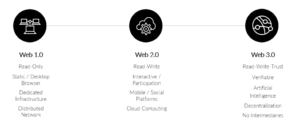Lately, experts and enthusiasts have been writing a lot about the evolution of the web and the concepts of centralized vs. decentralized networks. I was starting to feel comfortable with the concept of cryptocurrencies and a new term that everyone’s been talking about recently – non-fungible tokens (NFTs), which has caught my attention. Understanding these concepts is one thing, but what’s even more interesting is how these concepts are linked to the future of ecommerce.
Let’s explore the evolution of the web
A recent article in SFExaminer explained how the web has evolved. The visual below should help summarize each version. The descriptions are the learnings from a collection of articles available publicly.

The web is clearly not the place to just get information, but a space where people can interact, find entertainment and products to shop, place orders for delivery, create digital content to share with others, conduct banking, and much more. Web3 has brought a new dimension to all of this.
For instance, Web2 allows you to interact with people via test/video or make plans to meet in person, whereas in Web3 you can make plans with them virtually. In Web2 you can find products, pay for them online, and get them delivered to your desired location. However, there are methods of paying via digital currency in Web3. Additionally, Web3 technologies are enabling higher security of transactions and privacy.
What’s So Great About Web3?
Built on blockchain technology, Web3 is giving power to the users by allowing them to own their data/information, build their own community to connect with people and seamlessly conduct business, create and share content, interact and entertain, and create and sell art. Speaking of art, that’s where NFT comes in. Let’s explore that first and then we can discuss its impact on the future of ecommerce. It’s your preference if you’d rather have an SNL skit explain that to you or if you’d rather go through a detailed article published in nerdwallet recently. Personally, I’d go for SNL – but to each their own.
What’s important to understand
NFTs are built on a blockchain just like cryptocurrencies. The difference is that cryptocurrencies are fungible, meaning one currency is the same as another. NFTs are non-fungible, meaning each one of them is unique. You can buy, sell, or trade an NFT but its unique identity remains the same. Additionally, the owner has certain rights such as they can control how the NFT gets used and distributed. So far, NFTs have been linked to art, music, collectibles, online gaming, and virtual reality sectors. Although its potential has very much been explored for other sectors as well, you can check out that article from Nerdwallet for further details.
It’s fascinating and intriguing to me to watch, learn, and be prepared for the opportunities within our world of ecommerce. If we’re really thinking about it, chances are that someone else is already thinking, researching, and writing about this as well. A recent Inc article highlighted that Web3 and NFTs will be a common plan in ecommerce stores in less than five years. The concept of buying products on the web using smart contracts built on blockchain is already a popular topic of discussion. This is designed to increase trust between the buyers and the sellers.
NFTs are unique
They can be used in ecommerce by linking a token to each transaction. Let’s think about the monetization of loyalty awards. For each transaction, an NFT can be linked to the dollar amount spent. Those tokens can then allow the user to redeem points (or tokens) on future purchases against the exact value of the transaction. Today, we do not always know what our points are worth, and we must track if the points will expire on a certain date. With NFTs, the points or tokens will be tracked, the value and the source will be known, and it will bring trust in future transactions.
Let’s explore an example
The company classpass, which became the largest aggregator of health clubs and got a unicorn status a couple of years ago, is halfway there in the implementation of the concept of NFT – but in a limited manner. Their app currently gives credits/points to each user based on their monthly subscription tier and users can pay for any classes using those credits and even buy more credits in case a certain class is valued at more credits than what is available on their account.
But what if they build their functionality on a blockchain and use NFTs to uniquely identify the credits within each account and allow users to decide how to spend those credits securely? For example, the tokens/credits could potentially be transferred or sold to someone else if the user desires. More trust, less fraud, no returns, and potentially increase in value of the fitness programs.
Hop on the NFT Bandwagon With Me
NFTs are being explored and linked from the physical world to the online communities where people can be uniquely identified, own their intellectual property (IP) online, transact using credits and digital currencies, participate in events, and much more. It is certainly something to watch for, learn from, and eventually adapt to.
To connect with me more in-depth on this topic, feel free to connect with me on LinkedIn. For other questions, contact our commerce experts today.


Web3, I think, will have great tangible effects on our life than NFTs. Crypto, NFTs & Metaverse are already controversial, on the other hand Web3 has remained a less debatable topic than its counterpart technologies.